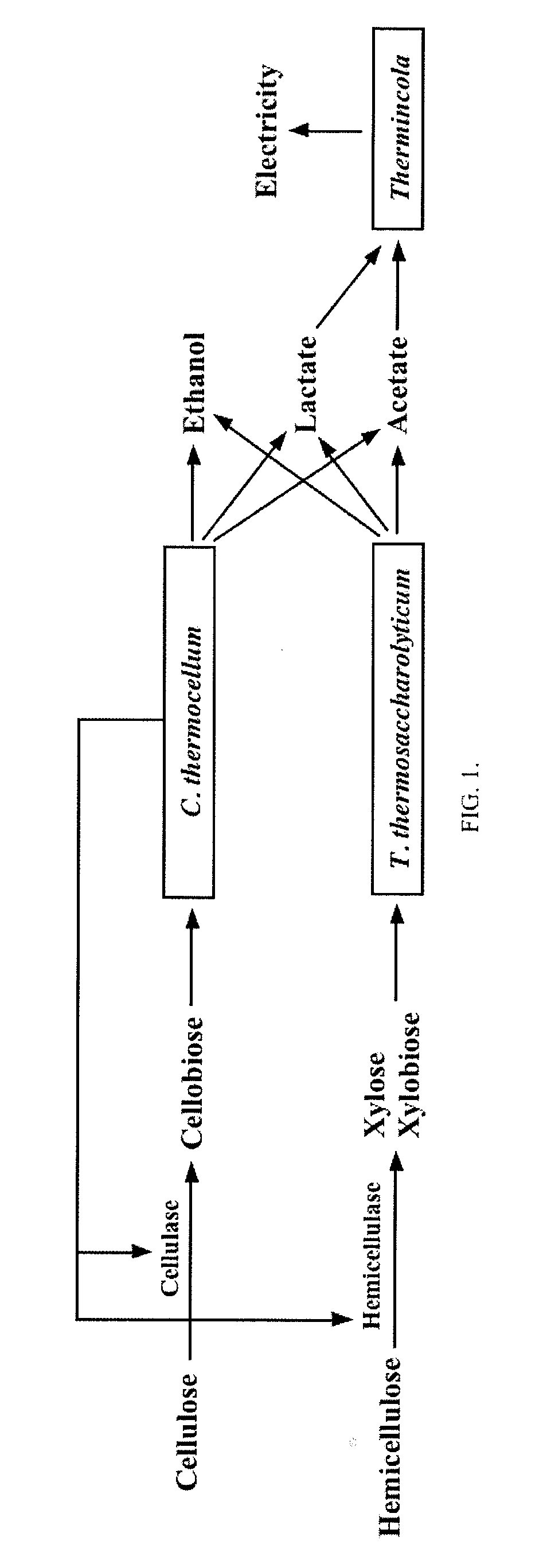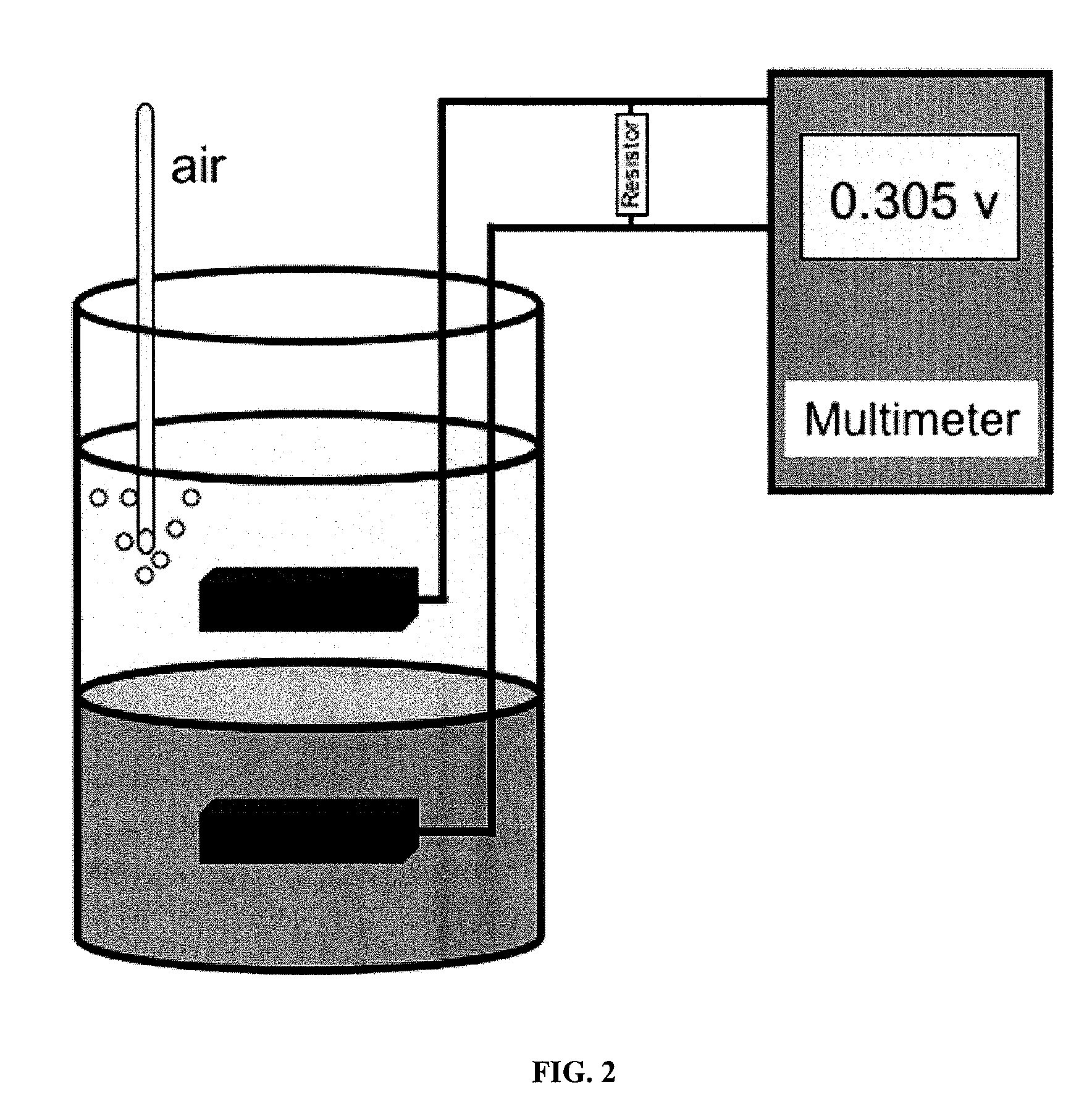Apparatus and methods for the production of ethanol, hydrogen and electricity
a technology of electricity and hydrogen, applied in the field of microorganisms, biochemistry, biofuels, etc., can solve the problems of limited ethanol yield, modest energy gain, and low ph, and achieve the effect of increasing the reaction rate and being less expensiv
- Summary
- Abstract
- Description
- Claims
- Application Information
AI Technical Summary
Benefits of technology
Problems solved by technology
Method used
Image
Examples
example 1
Enrichment and Isolation of Thermophilic Microorganisms from Marine Sediment
[0127]1. Methods
[0128]a. Sediment Fuel Cells
[0129]Anoxic marine marsh sediment 2 to 30 cm below the sediment surface was collected along the banks of the mouth of the Ashley River within Charleston Harbor (Charleston, S.C., USA). Screening was performed in sediment fuel cells (FIG. 2). In particular, sediment fuel cells similar to those described by Holmes et al. (2004) were constructed as follows: sediment free of shells and plant detritus was made homogenous by stirring and was added to the 250 ml mark of 600 ml beakers, which were then filled to the 500 ml mark with harbor water. Approximately 50 ml of ddH2O was added daily to replace water lost to evaporation. Placing a flask of water in the oven helped to minimize evaporation in the sediment fuel cells. Graphite electrodes with a surface area of 6.7 cm2 were prepared with marine-grade wire as previously described (Milliken, 2007). Those serving as anode...
example 2
Simultaneous Production of Ethanol and Electricity in Microbial Fuel Cells with Cellulose as a Carbon Source Under Thermophilic Conditions
[0165]1. Methods
[0166]a. Microorganisms
[0167]Electricigenic microorganisms used in this example were either a pure culture of Thermincola ferriacetica (DSM 14005) which was purchased from the German Resource Centre for Biological Material or a mixed culture enriched and isolated from marine sediment as shown in EXAMPLE 1. The both cultures were grown in a serum bottle containing 10 mM of sodium acetate, 15 mM of insoluble iron oxyhydroxide, 0.1% of yeast extract with the ECL medium at 60° C.
[0168]Ethanologenic microorganisms used in this example was a pure culture of Clostridium thermocellum 651 (ATCC 27405) which was purchased from the American Type Culture Collection. The inventors also attempted to use Thermoanaerobacterium thermosaccharolyticum NCA 3814 (ATCC 7956) in combination with C. thermocellum. T. thermosaccharolyticum is known to conve...
example 3
Simultaneous Production of Ethanol and Electricity in Microbial Fuel Cells with Crushed Peach as a Carbon Source Under Thermophilic Conditions
[0180]1. Methods
[0181]a. Microorganisms
[0182]Microorganisms used in this example are basically the same as those in EXAMPLE 2. A mixed culture enriched and isolated from marine sediment was used as electricigens. A pure culture of Clostridium thermocellum 651 was used as ethanologens. However, the inventors never used a pure culture of Thermincola ferriacetica in this example.
[0183]b. Medium Preparation
[0184]To prepare the medium containing peach, frozen peach without skin and seeds was thawed, and 10 g of wet peach was crushed and mixed with 90 g of ECL medium using a blender. This peach-containing medium was autoclaved at ˜110° C. for 15 min. According to Nutrition Facts provided by the peach supplier, 100 ml of this medium should contain 0.93 g of total carbohydrate, 0.14 g of fiber (cellulose), and 0.64 g of total sugars. C. thermocellum w...
PUM
 Login to View More
Login to View More Abstract
Description
Claims
Application Information
 Login to View More
Login to View More - R&D
- Intellectual Property
- Life Sciences
- Materials
- Tech Scout
- Unparalleled Data Quality
- Higher Quality Content
- 60% Fewer Hallucinations
Browse by: Latest US Patents, China's latest patents, Technical Efficacy Thesaurus, Application Domain, Technology Topic, Popular Technical Reports.
© 2025 PatSnap. All rights reserved.Legal|Privacy policy|Modern Slavery Act Transparency Statement|Sitemap|About US| Contact US: help@patsnap.com



